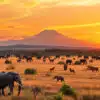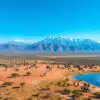Understanding Kenya’s Climate
Before embarking on a safari in Kenya, it’s essential to understand that the country’s climate is as diverse as its wildlife. Straddling the equator, Kenya has a variety of climatic conditions, broadly categorized into tropical, arid, and semi-arid. The central highlands, including Nairobi, enjoy a temperate climate with four distinct seasons. Coastal regions are typically hot and humid, while the north and northeast areas are hot and dry.
Best Times to Visit for Safari
The best times to experience a safari in Kenya are during the dry seasons, which occur from late June to October and from December to March. These periods offer optimal wildlife-viewing opportunities as animals congregate around water sources and the vegetation is sparse, making sightings more frequent and clear.
The Wet Seasons
While the dry seasons are prime for safaris, Kenya also experiences two wet seasons. The long rains typically occur from March to May and can be characterized by heavy downpours often in the afternoon or evening. The short rains happen from late October to December. During these times, many roads become impassable and game drives can be challenging. However, the wet seasons also bring lush landscapes and the chance to see newborn animals and migratory birds.
Temperature Fluctuations
Despite being near the equator, Kenya’s diverse topography leads to significant temperature variations. In the highlands, temperatures can range between 10°C to 25°C, while the coastal regions are warmer, with an average range from 22°C to 30°C. It’s cooler at higher altitudes, so for safaris in areas like the Maasai Mara, one should be ready for chilly mornings and evenings.
What to Pack
Packing for a Kenyan safari requires preparation for all contingencies. Light, breathable clothing is suitable for daytime, while warmer layers are essential for early morning and evening game drives. Waterproof gear is recommended during the wet seasons, and regardless of when you visit, always pack sunscreen, a hat, and sunglasses to protect against the strong equatorial sun.
Regional Considerations
Different regions in Kenya experience varying microclimates. For example, the coastal regions’ weather can differ significantly from the weather in the Maasai Mara. It’s advisable to check specific regional forecasts and consult with your safari operator to ensure you’re prepared for the conditions you’ll encounter in the particular areas you plan to visit.
Staying Flexible on Your Safari
Weather in Kenya can be unpredictable, with sudden changes that could alter your safari itinerary. Flexibility and a good sense of adventure are crucial. Sometimes, what seems like unfavorable weather can result in unique wildlife interactions and photographic opportunities.
Conclusion
Kenya’s weather is an integral part of the safari experience, with each season offering its unique charms. With the right preparation, you can enjoy your journey through Kenya’s magnificent landscapes and spectacular wildlife showcases, regardless of when you choose to visit. Understanding the climate and packing accordingly will go a long way in ensuring your Kenyan safari is an unforgettable adventure.



